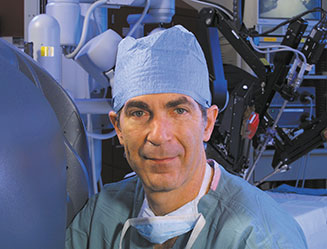Breakthrough device eliminates injuries during kidney stone removal
UCI Health force sensor instrument reduces ureteral injuries to zero

UC Irvine researchers have developed a breakthrough device that prevents injury when kidney stones are treated through the ureter.
In a clinical study of 200 kidney stone patients, the force-sensor instrument reduced the chance of ureteral injury — seen previously in as many as 23% of cases — to zero, said UCI Health urologist Dr. Ralph V. Clayman, co-author of the study report, which has been accepted for publication in the Journal of Urology.
At a time when one out of 10 Americans are likely to suffer kidney stones in their lifetime, Clayman said the ability to control the force with which ureteral access sheaths are inserted into the ureter is a "game changer" — making the procedure easier for surgeons, more successful in removing kidney stones and reducing the patient's chances of recurrent stone attacks.
Force control makes the difference
Clayman, a distinguished professor of urology and dean emeritus of the UCI School of Medicine, explains how urologists remove kidney stones with a ureteroscope without the need for any incisions.

“The ureteroscope, which is only one-eighth of an inch in diameter, allows the surgeon to move across the urethra, bladder and ureter and enter the kidney, all through normal passageways,” he said.
“The ureteroscope is commonly passed through an outer sheath that protects the ureter during stone extraction and facilitates passage of the ureteroscope into the kidney. Stones are then fragmented using a laser fiber that is the size of three human hairs.”
The force exerted while inserting the access sheath makes the difference between injuring the ureter or not.
Even in the most experienced of hands, Clayman explains, sheath placement results in splitting the ureter in 13% to 23% of cases. While this doesn’t usually result in permanent damage, it does require the patient to keep a stent in place for an extra one to four weeks to allow the ureter to heal — an uncomfortable complication at best.
Safe passage of access sheaths
In laboratory and clinical studies, the urology research team confirmed that the ureter is able to tolerate up to 6 newtons of force, the equivalent of 1.35 pounds, without incurring injury. When the insertion force is kept at or below this threshold, the injury rate fell to zero, he said.
The urology-dedicated force sensor system was developed at the UCI Department of Urology’s Curiosity and Innovation Laboratory in collaboration with Michael Klopfer, PhD, technical director for the California Plug Load Research Center at UC Irvine.
The force sensor ensures safe passage of the ureteral access sheath by monitoring the force used to position it and keeping that force below 6 newtons as measured in real-time.
The system is comprised of a hand-held unit with a force gauge coupled with a catheter that is used to insert the sheath into the ureter. The device links wirelessly to a tablet computer that logs real-time force readings as the ureteral access sheath is positioned.
Shorter procedure, improved stone removal
Sensor placement gives the surgeon the confidence to use a larger ureteral access sheath, which makes it easier to pass the ureteroscope multiple times to remove more fragments of kidney stones in less time.
What that means for both surgeon and patient is a significantly shortened procedure — 90 minutes compared to 140 minutes — and more than doubling the number of stones that can be removed when using smaller access sheaths.
It's important to remove as many stones as possible, Clayman said, adding that some urologists break up kidney stones but don’t remove them.
Patients then have to wait for the stone fragments to pass through the ureter. Unfortunately, in as many as 40% to 50% of patients, these fragments remain in the kidney and may grow into another symptomatic stone.
“If stones are not completely removed, there’s a 20% chance they may grow back, requiring another treatment within two years,” he said.
UCI Health urologists are now using the device to treat patients at the UCI Health Kidney Stone Center.
Clayman, an internationally respected urologist who has pioneered minimally invasive surgical techniques that have revolutionized treatment for diseases of the kidney and urinary tract, is eager to make the force sensor device widely available so other urologists and their patients can benefit.
About UCI Health: UCI Health comprises the clinical enterprise of the University of California, Irvine. Patients can access UCI Health at primary and specialty care offices across Orange County and at its main campus, UCI Medical Center, in Orange, California. The 418-bed acute care hospital provides tertiary and quaternary care, ambulatory and specialty medical clinics, and behavioral health and rehabilitation services. UCI Medical Center is home to Orange County’s only National Cancer Institute-designated comprehensive cancer center and high-risk perinatal/neonatal program, as well as American College of Surgeons-verified Level I adult and Level II pediatric trauma center and regional burn center. It is the primary teaching hospital for the UCI School of Medicine. UCI Health serves a region of nearly 4 million people in Orange County, western Riverside County and southeast Los Angeles County. Follow UCI Health on Facebook and Twitter.




